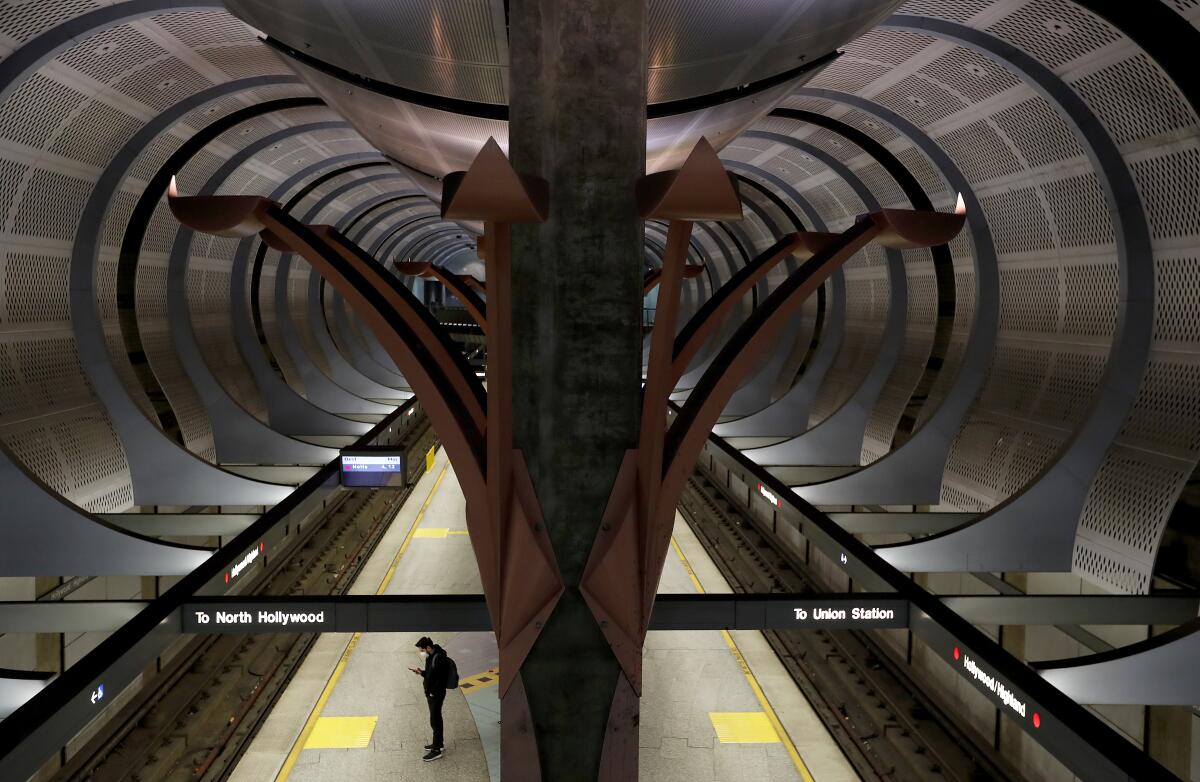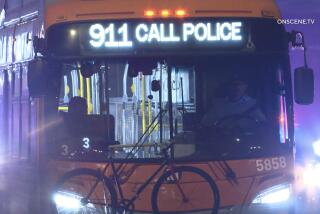Metro expects ‘massive’ budget hit from coronavirus as ridership plummets

- Share via
Ridership on California’s largest transit system has fallen by more than half during the coronavirus outbreak as life in Los Angeles County has all but ground to a halt, officials said Friday.
On Wednesday, trips on the Metropolitan Transportation Authority’s six rail lines were down nearly two-thirds compared with a typical day, and bus ridership was down by about 53%, the agency said.
Metro does not plan to shut down the system, which is a “lifeline” for people who still need to commute to essential jobs, take care of relatives, go to medical appointments and run errands, Chief Executive Phil Washington said Friday.
But officials will make immediate service cuts. Bus service will be reduced 15% to 20%. Trains will run less frequently during rush hour and will stop running at midnight on Fridays and Saturdays.
Though drastic, Metro’s ridership decline is slightly less dire than what other major cities are seeing. New York City’s subway has lost 70% of its riders. Trips on the Bay Area’s commuter rail, BART, has cratered by almost 90%.
Metro’s buses and trains are cleaned daily. Crews have strengthened their cleanings of areas that riders are most likely to touch, both in transit and in stations, said Jim Gallagher, the agency’s chief operating officer.
That includes handrails, ticketing machines, seats, escalator rails and elevator buttons. Bathrooms at Union Station are now being cleaned every half-hour, he said.
Metro has ordered dispensers for hand sanitizer to install at major transit hubs, which transit advocates had asked for earlier this week. The agency is also exploring the idea of equipping trains and buses with similar dispensers, Gallagher said.
Where the dispensers are installed will “depend on how many we get, and when,” Gallagher said. “Our experience on these emergency supplies is that we order larger quantities and they come in smaller quantities.”
No known cases of COVID-19 in Los Angeles County can be traced to a bus or train, officials said. No Metro employee has tested positive for COVID-19, officials said. Metro is not conducting widespread testing due to a shortage of tests, said Ken Hernandez, the agency’s chief risk safety and asset management officer.
Between the service cuts and the declining demand for transit rides, Metro should not have a problem staffing enough operators to run buses and trains, Washington said.
How Metro’s operations will look after the COVID-19 pandemic ends is still unclear.
Following the stay-at-home orders imposed by Gov. Gavin Newsom and Los Angeles County officials on Thursday night, all but the most essential businesses have closed. Commercial centers have been eerily empty for more than a week.
Metro is facing “a massive financial hit” as nonessential spending grinds to a halt and sales tax revenue plummets, Washington said. He added: “We don’t know the totality of that effect yet but we are preparing and bracing for it.”
Metro is one of the most heavily subsidized major transit systems in the world. Passenger fares cover about 15% of transit operations, according to the agency’s budget. Metro receives 2 cents for every dollar spent in the county from sales tax increases approved by voters in 1980, 1990, 2008 and 2016.
The current fiscal year budget, approved last summer, had a rosy economic outlook, forecasting a 3.4% increase, or $116 million more, in sales tax revenue. Now, revenues will certainly fall compared with last year, though by how much is unclear.
Metro is exploring whether the federal government can reimburse its coronavirus costs, Washington said. He declined to say how much Metro has spent so far, but said it was being tracked on a specific budget line item.
The union that represents most American bus drivers asked Congress on Friday to provide a $16-billion emergency bailout to U.S. transit systems to cover “extraordinary direct costs and revenue losses.” Earlier this week, the American Public Transportation Assn. requested almost $13 billion.
More to Read
Sign up for Essential California
The most important California stories and recommendations in your inbox every morning.
You may occasionally receive promotional content from the Los Angeles Times.











